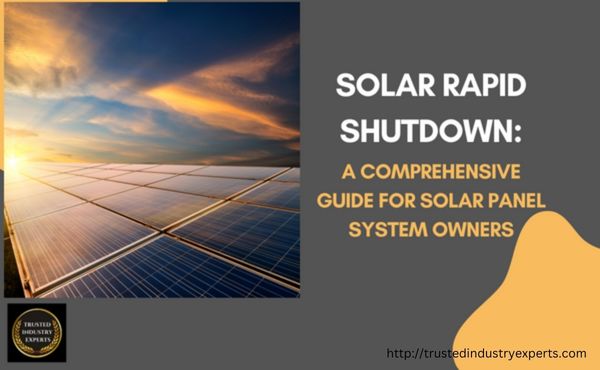Solar Rapid Shutdown: A Comprehensive Guide for Solar Panel System Owners

Solar panel systems have become increasingly popular in recent years due to their cost-effectiveness and eco-friendliness.
However, as these systems grow in popularity, safety concerns also arise.
One such concern is the potential danger posed by high voltage electrical current that runs through the panels in the event of a fire or other emergency.
To address this concern, the National Electrical Code has introduced a new requirement known as Solar Rapid Shutdown (SRS).
We will dive into what Solar Rapid Shutdown is, why it’s important, and how it works.
We will also provide a step-by-step guide on how to implement it into your solar panel system, so you can ensure the safety of your family, property, and first responders.
What is Solar Rapid Shutdown?
Solar Rapid Shutdown (SRS) is a new requirement introduced by the national electrical code that mandates that all solar panel systems be equipped with a mechanism to rapidly shut down the electrical current running through the panels in the event of a fire or other emergency.
This new requirement is meant to provide an extra layer of protection to first responders, who would otherwise be at risk of electrocution when responding to a fire involving a solar panel system.
With SRS, the electrical current running through the panels is having rapid shutdown function, reducing the risk of injury to first responders and making it easier for them to safely respond to emergencies.
What is Solar Rapid Shutdown (SRS) and How Does It Benefit Homeowners?
With the rise of solar panels, many home owners have been taking advantage of renewable energy sources to generate electricity for their homes.
However, what many do not realize is that there are certain safety requirements for solar PV systems.
One such requirement is Solar Rapid Shutdown (SRS). Let’s take a closer look at SRS and how it can benefit homeowners.
What is Solar Rapid Shutdown?
Solar Rapid Shutdown (SRS) is an electrical safety requirement for solar PV systems.
To put it simply, SRS ensures that the DC power from the solar panels can be quickly shut off when necessary.
This could be due to maintenance or emergency situations, where a rapid shutdown function of ac power may be necessary.
In order to meet this requirement, local installers must now incorporate a rapid shutdown box into their PV system installations.
How Does SRS Benefit Homeowners?
The primary benefit of SRS is that it improves safety by allowing installers to reduce fire hazards in case of an emergency situation and allows workers to safely access the roof without risk of electrocution during maintenance work on the system.
The installation of a rapid shutdown compliance box also means that other components in the system will run more efficiently and with less downtime as they no longer need to be manually shut down during maintenance or repair work.
This makes installation simpler, more efficient, and more cost-effective for homeowners in the long run.
In addition, having an SRS-compliant system may qualify homeowners for certain tax credits or incentives from their local government or utility company.
While these incentives vary depending on location, they can amount to significant savings for homeowners who invest in an SRS-compliant solar PV system.
Solar Rapid Shutdown device is an important electrical safety requirement for all solar inverter systems installed today, as it helps reduce fire hazards and enables workers to access roofs safely while performing maintenance work on the system.
Not only does having an SRS-compliant system help improve safety, but it can also save home owners money through tax credits or incentives offered by their local government or utility company!
Overall, investing in an SRS-compliant solar array system is not only essential but beneficial for any homeowner looking to take advantage of renewable energy sources!
Why is Solar Rapid Shutdown Important?
The primary reason for the introduction of Solar Rapid Shutdown is to increase the safety of first responders in the event of a fire or other emergency involving a solar panel system.
In the past, first responders have been at risk of electrocution when responding to emergencies involving solar panels, due to the high voltage electrical current running through the panels.
What is Solar Rapid Shutdown and Why is it Important?
We’ve all heard of solar power, but what about Solar Rapid Shutdown?
Put simply, Solar Rapid Shutdown (SRS) is an important safety feature for photovoltaic (PV) systems that helps reduce the risk of electric shock or electrocution.
We’ll discuss why SRS is such an important safety consideration for homeowners who are considering installing solar panels on their home.
What is Solar Rapid Shutdown?
Solar Rapid Shutdown (SRS) is a set of safety requirements that are used to quickly shut down a PV system during emergency situations.
It works by using a rapid shutdown box installed at the location of the PV array which can be triggered remotely or automatically in the event of an emergency.
This ensures that anyone working on or near the system will have enough time to get away and avoid potential electric shocks or electrocutions.
Why Should Homeowners Consider Installing SRS?
The main reason homeowners should consider installing SRS is for safety reasons. It’s important to note that while PV systems are generally safe and pose no greater risk than other sources of electricity, they do carry some risks due to their large size, high voltage, and potential for unexpected electrical events.
By installing SRS, homeowners can help ensure that their PV system remains safe during any work being done on it or during emergency situations.
Additionally, having SRS installed may also qualify them for certain incentives from their local utility company as many companies are now offering rebates for those who install SRS into their PV systems.
Are There Any Drawbacks to Installing SRS?
The primary drawback to installing SRS is cost; it can be expensive depending on the type and size of your system. Additionally, while most modern solar panel systems come with pre-installed rapid shutdown boxes, older systems may require additional components in order to make them compatible with SRS.
However, given the potential risks associated with not having a rapid shutdown system in place, these considerations should not deter homeowners from investing in one if they are considering photovoltaic panels as a source of energy at their home.
Photovoltaic (PV) systems
Solar Rapid Shutdown (SRS) is an important safety feature for photovoltaic (PV) systems that helps reduce the risk of electric shock or electrocution. While there are some costs associated with installation and compatibility issues with older systems may present challenges, these should not deter homeowners from investing in this vital safety feature if they are considering adding solar system to their homes.
Taking the necessary steps to ensure your home’s safety will give you peace of mind knowing that you’re taking every precaution possible when it comes to managing your own energy source responsibly and safely!
With SRS, the electrical current is rapidly shut down, reducing the risk of injury to first responders and making it easier for them to safely respond to emergencies. This is particularly important in the event of a fire, where time is of the essence and the safety of first responders must be ensured.
How Does Solar Rapid Shutdown Work?
Solar Rapid Shutdown works by using a control device, such as a relay or circuit breaker, to rapidly shut down the electrical current running through the panels in the event of a fire or other emergency. This control device is triggered by a switch located near the inverter, which is the central component of the solar system.
When the switch is activated, the control device rapidly shuts down the electrical current running through the panels, reducing the risk of injury to first responders and making it easier for them to safely respond to emergencies.

How to Implement Solar Rapid Shutdown in Your Solar Panel System
Implementing Solar Rapid Shutdown in your solar systems is relatively straightforward, and can be done by following these steps:
Determine the size of your solar panel system and select an appropriate control device, such as a relay or circuit breaker.
Choosing the size of your solar panel system is a vital part of maximizing efficiency in the long-term. As module level power electronics become more commonplace, many homeowners are realizing that selecting an appropriate control device, such as a relay or circuit breaker is also essential for creating an effective solar energy solution.
When taking into account all elements of how solar panels work together with a solar inverters to power your home, you can save energy, time, and money when you correctly determine the size and select applicable control devices.
Install the control device near the inverter.
Installing the control device near the string inverters module level power electronics is a necessary step in order to get the most out of your pv arrays. This device is designed to de energize your energy generated when functioning properly, allowing for maximum efficiency and keeping you secure from electric overload.
Placement is key when it comes to finding success. By taking the time to install this device near the inverters, you will be able to reap all of the benefits intended with this module level power electronics technology.
Install a switch near the inverter that will trigger the control device in the event of a fire or other emergency.
Installing a switch near the string inverters is an important part of rapid shutdown compliance, as it helps to ensure rapid shutdown of the live wires in times of emergency.
In the event of a fire or other emergency, triggering this switch will activate the rapid shutdown device, helping to protect personnel from contact with the exposed lives wires and avert any potential damage or harm. It’s an invaluable tool for quick action and provides peace of mind that all necessary precautions are in place for swift responses to unexpected events.
Connect the control device to the switch, ensuring that it is properly wired and functioning correctly.
When connecting the control device to the switch, inverters must be taken into consideration as they could cause an issue if wired incorrectly. Expertise and care is required when wiring these inverters, due to being exposed to live wires which can put the system (and those working on it) at risk.
Furthermore, ensuring that the inverter capacity matches the system size is of utmost importance. Alternating current must also comply with national electrical code regulations for safety and functionality standards, so verifying this should not be overlooked either. All in all, taking extra precaution when wiring can help ensure successful and safe operation of the control device and switch.
Test the system to ensure that it is working as intended and that the electrical current running through the panels can be rapidly shut down in the event of an emergency.
Testing a solar panel system is essential for generating the most efficient and impressive results. As an example, on sunny summer days, an array of solar panels can generate enough electricity to power an entire home—the first step is always testing.
These tests give us the peace of mind that the electrical current running through these rooftop installations can be quickly shut down in the event of an emergency. Aside from such risk concerns, testing allows us to commit to other energy-saving options and ensure that our system runs as intended.
Along with protium testing, any good installation will include putting the system in direct contact with the ground—a great way to finish off your setup and potentially save on energy costs in the long run.
Secure your safety
Securing the safety of your family, property and first responders can be done through simple, preventative steps. Ensuring smoke detectors are installed and functioning properly can provide early detection in the case of a fire incident. Preparing a home evacuation plan could make all the difference in an emergency situation when time is of the essence.

Making sure that ladders are available for second story windows allows for an escape route to be opened if necessary. Additionally, establishing an area away from doors and windows where family members can meet will help ensure everyone is safe after an evacuation occurs.
Following these preventive steps will give you peace of mind knowing that your loved ones, residence, and even first responders have been given extra protection in times of danger.
Go solar with Trusted Industry Experts and Contact us here
#Solarenergy #SolarPanels #SRS #PowerSystems #PhotovoltaicSystems #SafetyFirst #TaxCredits #Incentives #RenewableEnergy #EnergyEfficiency #Homeownership #GreenLiving



